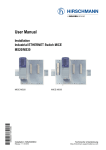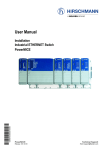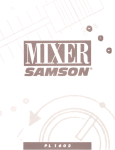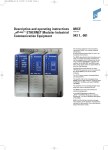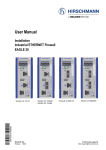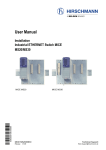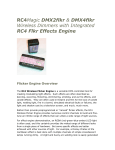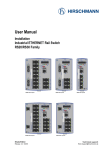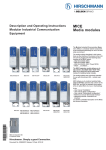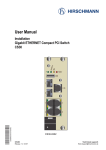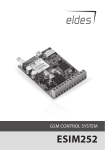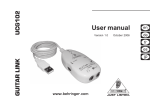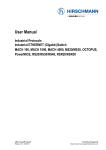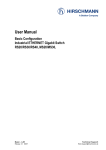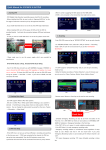Download User Manual
Transcript
User Manual Installation Industrial ETHERNET Switch MICE MS20/MS30 . MICE MS20 MICE MS20/MS30 Release 2.0 02/06 MICE MS30 Technical support [email protected] The naming of copyrighted trademarks in this manual, even when not specially indicated, should not be taken to mean that these names may be considered as free in the sense of the trademark and tradename protection law and hence that they may be freely used by anyone. © 2006 Hirschmann Automation and Control GmbH Manuals and software are protected by copyright. All rights reserved. The copying, reproduction, translation, conversion into any electronic medium or machine scannable form is not permitted, either in whole or in part. An exception is the preparation of a backup copy of the software for your own use. The performance features described here are binding only if they have been expressly guaranteed in the contract. This publication has been created by Hirschmann Automation and Control GmbH according to the best of our knowledge. Hirschmann reserves the right to change the contents of this manual without prior notice. Hirschmann can give no guarantee in respect of the correctness or accuracy of the details in this publication. Hirschmann can accept no responsibility for damages, resulting from the use of the network components or the associated operating software. In addition, we refer to the conditions of use specified in the license contract. Printed in Germany (9.2.06) Hirschmann Automation and Control GmbH Stuttgarter Straße 45-51 72654 Neckartenzlingen Tel. +49 1805 141538 039 530-001-02-0206 Content Safety instructions 4 About this manual 9 Legend 9 1 Device description 10 1.1 Description of the device variants 1.1.1 MS20-... /MS30-... combination options 1.1.2 Number of ports and media 1.1.3 Media modules 1.1.4 MB - 2T expansion module 1.1.5 SFP module 11 13 14 16 20 20 2 Assembly and startup procedure 21 2.1 Device installation 2.1.1 Unpacking and checking 2.1.2 Assembling the media modules 2.1.3 Filling out and attaching the labels 2.1.4 Assembling the SFP modules 2.1.5 Adjusting the DIP switch settings on the basic module 2.1.6 Adjusting the DIP switch settings on the MICE MM3-2AUI media module (if existent) 2.1.7 Terminal block for supply voltage and signal contact 2.1.8 Connecting the terminal blocks, startup procedure 2.1.9 Assembling the device on the ISO/DIN rail, grounding 2.1.10Connecting the data lines 2.1.11Assembling the MB - 2T expansion module 2.1.12Define the meaning of the display LEDs 21 21 21 22 23 23 24 25 26 26 27 29 29 2.2 Displays 30 2.3 Carrying out basic settings 34 2.4 Disassembling 36 3 Technical data 37 Further support 43 MS20/MS30 Release 2.0 02/06 3 Safety instructions This manual contains instructions which must be observed to ensure your own personal safety and to avoid damage to devices and machinery. U Certified usage Please observe the following: The device may only be employed for the purposes described in the catalog and technical description, and only in conjunction with external devices and components recommended or approved by Hirschmann. The product can only be operated correctly and safely if it is transported, stored, installed and assembled properly and correctly. Furthermore, it must be operated and serviced carefully. U Supply voltage The devices are designed for operation with a safety extra-low voltage.Thus, they may only be connected to the supply voltage connections and to the signal contact with PELV circuits or alternatively SELV circuits with the voltage restrictions in accordance with IEC/EN 60950. The supply voltage is electrically isolated from the housing. V Use only undamaged parts! V Relevant for North America: The subject unit is to be suppplied by a Class 2 power source complying with the requirements of the National Electrical Code, table 11(b). If power is redundant supplied (two individual power sources) the power sources together should comply with the requirements of the National Electrical Code, table 11 (b). V Relevant for North America: Use 60/75°C or 75°C copper(CU)wire only. V Relevant for North America for devices certified for hazardous locations: Power, input and output (I/O) wiring must be in accordance with Class I, Division 2 wiring methods [Article 501-4(b) of the National Electrical Code, NFPA 70] and in accordance with the authority having jurisdiction. U Shielding ground The shielding ground of the connectable twisted pairs lines is connected to the front panel as a conductor. V Beware of possible short circuits when connecting a cable section with conductive shielding braiding. 4 MS20/MS30 Release 2.0 02/06 U Housing Only technicians authorized by Hirschmann are permitted to open the housing. The lower covering panel of the MICE housing is grounded by the DIN rail and, as an option, by the separate ground screw. The switch basic module forms an inseparable unity. By removing the display and connecting parts, you risk the damage of the switch basic module. V Make sure that the electrical installation meets local or nationally applicable safety regulations. V The ventilation slits must not be covered to ensure free air circulation. V The distance to the ventilation slots of the housing has to be a minimum of 10 cm. V Never insert pointed objects (thin screwdrivers, wires, etc.) into the inside of the subrack! Failure to observe this point may result in injuries caused by electric shocks. V The device has to be mounted in an upright position (see Fig. 13). V If installed in a living area or office environment, the device must be operated exclusively in switch cabinets with fire protection characteristics according to EN 60950. U Environment The device may only be operated in the listed maximum surrounding air temperature range at the listed relative air humidity range (non-condensing). V The installation location is to be selected so as to ensure compliance with the climatic limits listed in the Technical Data. V To be used in a Pollution Degree listed in the Technical Data. U Qualification requirements for personnel Qualified personnel as understood in this manual and the warning signs, are persons who are familiar with the setup, assembly, startup, and operation of this product and are appropriately qualified for their job. This includes, for example, those persons who have been: D trained or directed or authorized to switch on and off, to ground and to label power circuits and devices or systems in accordance with current safety engineering standards; D trained or directed in the care and use of appropriate safety equipment in accordance with the current standards of safety engineering; D trained in providing first aid. MS20/MS30 Release 2.0 02/06 5 U General Safety Instructions This device is electrically operated. Adhere strictly to the safety requirements relating to voltages applied to the device as described in the operating instructions! Failure to observe the information given in the warnings could result in serious injury and/or major damage. V Only personnel that have received appropriate training should operate this device or work in its immediate vicinity. The personnel must be fully familiar with all of the warnings and maintenance measures in these operating instructions. V Correct transport, storage, and assembly as well as careful operation and maintenance are essential in ensuring safe and reliable operation of this device. V Only use undamaged parts! V These products are only to be used in the manner indicated in this version of the manual. V Any work that may have to be performed on the electrical installation should be performed by fully qualified technicians only. Warning! LED- or LASER components according to IEC 60825-1 (2001): CLASS 1 LASER PRODUCT. LIGHT EMITTING DIODE - CLASS 1 LED PRODUCT. Warning (MM2 - 2FXP4, MM3 - 4FXP4) LED LIGHT DO NOT STARE INTO THE BEAM OR VIEW DIRECTLY WITH OPTICAL INSTRUMENTS (e.g. lens, microscope). Failure to observe this warning within a distance of 100 mm can endanger your eyes. Light is emitted from the optical connections or from the ends of the optical fibers that are connected to them. Light Emitting Diode CLASS 2M, Wave length 650 nm, Power <2 mW, according to IEC/CEI 60825-1:2003-10. U National and international safety regulations V Make sure that the electrical installation meets local or nationally applicable safety regulations. 6 MS20/MS30 Release 2.0 02/06 U ESD guidelines (MM2 - 2FXP4, MM3 - 4FXP4) The media modules MM2-2FXP4 and MM3-4FXP4 contain components highly sensitive to electrostatic fields. These components can be easily destroyed or have their lives shortened by an electrical field or by a discharge caused by touching the contacts. You can find more information about devices vulnerable to electrostatic fields in DIN EN 61340-5-1 (2001-08) and DIN EN 61340-5-2 (2002-01). U Note on the CE marking The devices comply with the regulations contained in the following European directives: 89/336/EEC Directive of the council for standardizing the regulations of member states on electromagnetic compatibility (changed by RL 91/263/EEC, 92/ 31/EEC and 93/68/EEC). In accordance with the above-named EU directives, the EU conformity declaration will be at the disposal of the relevant authorities at the following address: Hirschmann Automation and Control GmbH Stuttgarter Straße 45-51 D-72654 Neckartenzlingen Germany Phone ++49 7127 14 1480 The product can be used in living areas (living area, place of business, small business) and in industrial areas. D Interference immunity: EN 61000-6-2:2001 D Emitted interference: EN 55022:1998 + A1 2000 + A2 2003 Class A Warning! This is a class A device. This device can cause interference in living areas, and in this case the operator may be required to take appropriate measures. The assembly guidelines provided in these instructions must be strictly adhered to in order to observe the EMC value limits. MS20/MS30 Release 2.0 02/06 7 U FCC note: Appropriate testing has established that this device fulfills the requirements of a class A digital device in line with part 15 of the FCC regulations. These requirements are designed to provide sufficient protection against interference where the device is being used in a business environment. The device creates and uses high frequencies and can radiate same, and if it is not installed and used in accordance with this operating manual, it can cause radio transmission interference. The use of this device in a living area can also cause interference, and in this case the user is obliged to cover the costs of removing the interference. U Recycling note: After usage, this product must be disposed of properly as electronic waste in accordance with the current disposal regulations of your county / state / country. 8 MS20/MS30 Release 2.0 02/06 About this manual The following manuals are included as PDF files on the enclosed CD ROM: D D D D D User manual “Installation” User manual “Basic configuration” User manual “Redundancy configuration” Reference manual “Web-based Interface” and Reference manual “Command Line Interface” If you use Network Management Software HiVision you have further opportunities to: D D D D D D have an event logbook. configure the “System Location” and “System Name”. configure the network address range and SNMP parameters. save the configuration on the Switch. simultaneous configuration of several Switches. configure the relevant ports to be displayed red if there is no link state. Legend The commendations used in this manual have the following meanings: D Listing V Work step U Subheading MS20/MS30 Release 2.0 02/06 9 1 Device description The MS20/MS30 devices consist of a switch with media modules that can be plugged into it. They allow you to construct switched industrial ETHERNET networks that conform to the IEEE 802. and 802.3u standards using copper wires or optical fibers in a bus or ring topology. You can connect terminal devices and other infrastructure components via twisted pair cables, multimode LWL and single-mode LWL. The twisted pair ports support autocrossing, autonegotiation and autopolarity. MS20 MS30 Basic module Media module or slot for media module, No. 1 2 3 4 1 2 3 4 5 The MS20/MS30 devices provide you with a range of switch variants. You can set up your switch to meet your individual requirements with regard to the transmission media type, the number of 10/100 Mbit ports you want (8, 16 or 24), the number of 1000 Mbit ports (up to 2), the temperature range, voltage range, certificates and software variant. The MS20/MS30 devices are modular network components. They are designed for the special requirements of industrial automation. They meet the relevant industry standards, provide very high operational reliability, even under extreme conditions, and also long-term reliability and flexibility. The devices operate without fans and have a redundant voltage supply. The switches are very quickly mounted by snapping them onto a hat rail, which also automatically contacts the function ground. The HIPER-Ring redundancy concept enables you to quickly carry out a reconfiguration, and also a simple configuration with only one additional connection. The diagnosis display and the display of the operating parameters and the large label areas provide a quick overview. It can be easily managed via a Web browser, via Telnet, with a management software product (such as F) or locally on the switch (V.24 interface). 10 MS20/MS30 Release 2.0 02/06 Depending on the software you choose, the MS20/MS30 devices provide you with a large range of functions: D Redundancy functions (Rapid Spanning Tree, Redundant Ring Structure, HIPER-Ring, Redundant Coupling, Link Aggregation, Redundant Power Supply) D Protection from unauthorized access D Synchronized system time in the network D Network load control D Function diagnosis D Diagnostics (hardware self-testing) D Reset D Priority D VLAN D Topology recognition D Web-based interface D Command Line Interface - CLI D SNMP D 802.1x port authentication D Real Time Clock (Professional software variant) The addition, to the MS20/MS30 MICE range, of the RS20/RS30 Open Rail range of switches, the MACH range of backbone switches, the BAT wireless transmission system, the EAGLE security system, and products for the LION control room, provides continuous communication across all levels of the company. 1.1 Description of the device variants The industrial ETHERNET series MICE (Modular Industrial Communication Equipment) consists of a basic switch module and the media modules. These devices can be managed. A basic module contains all the functions of this industrial Gerät, with the exception of the interfaces to the LAN that is connected. Pluggable media modules provide these interfaces. They differ with regard to the number of interfaces and the media type for connecting segments. An expansion module enables you to add 2 slots for media modules to the basic module. For the sake of simplicity, the basic switch module with various plugged in media modules will be referred to as MICE in this document. D The MS20-... device variants are modular switches with up to 8, 16 or 24 * 10/100 Mbit Ethernet ports. You can choose the media for the ports via the media modules. MS20/MS30 Release 2.0 02/06 11 D The MS30-... device variants are modular switches with up to 8, 16 or 24 * 10/100 Mbit Ethernet ports and up to 2 additional Gigabit ports (1000 Mbit Ethernet). You can choose the media for the ports via the media modules. The devices also provide you with the following options for selecting the variant you desire: D Temperature range: D Standard (0 °C to +60 °C) D Extended (-40 °C to +70 °C) without conformal coating D Extended (-40 °C to +70 °C) with conformal coating D Voltage range: D 18 to 32 VDC (flatter basic module design) D 18 to 60 VDC (deeper basic module design) D Certifications: D CE, UL D CE, UL, German Lloyd (GL), IEC 61850 Declaration (Sub Station), IEEE 1613 (Sub Station), EN 50121-4 Railway (along track) D CE, UL, German Lloyd (GL), IEC 61850 Declaration (Sub Station), IEEE 1613 (Sub Station), EN 50121-4 Railway (along track), EN 50155 Declaration (Railway) and ATEX 100a (Hazardous Location) D Software version: Enhanced or Professional The devices comply with the specifications of the standards: ISO/IEC 8802-3u 100BASE-TX/-1000BASE-T, ISO/IEC 8802-3 100BASE-FX and ISO/IEC 8802-3 1000BASE-SX/LX. The basic module of the MICE contains all the function units, such as: switch function, management function, redundancy function, display control, voltage connection, management connection, adjustable controls, slots for media modules. Family MS20 MS30 12 Designed for Larger numbers of ports, number of 100 Mbit ports desired, temperature range, voltage range, certificates and software variant can be selected Larger numbers of ports and larger bandwidth requirement, number of 100/1000 Mbit ports desired, temperature range, voltage range, certificates and software variant can be selected MS20/MS30 Release 2.0 02/06 1.1.1 MS20-... /MS30-... combination options The product designation of your MS20/MS30 device is made from combining the desired product characteristics in accordance with the following table. The short designation is in column 3. Position 1 to 4 Attribute Produkt 5 6 to 7 - (hyphen) Number of 10/100 Mbit ports 8 and 9 Number of 1000 Mbit ports 14 Temperature range 15 Voltage range 16 Specifications Ident. MS20 MS30 08 16 24 00 02 S T E A C A H B 17 Software version E P Feature Modular Switch without gigabit ports Modular Switch with gigabit ports 8 * 10/100 Mbit Ethernet 16 * 10/100 Mbit Ethernet 24 * 10/100 Mbit Ethernet 0 * 1000 Mbit Ethernet 2 * 1000 Mbit Ethernet Standard 0 °C to +60 °C Extended -40 °C to +70 °C Extended -40 °C to +70 °C, conformal coating 18 VDC to 32 VDC 18 VDC to 60 VDC CE, UL CE, UL, GL, railway (along track), sub station CE, UL, GL, railway (along track), sub station, hazardous location (ATEX), railway (train) Enhanced Professional Table 1: Combination options of the MS20/MS30 device versions U Example: MS30-0802SAAE MS30-: Modular switch with gigabit ports 08: 8 x 100 Mbit Ethernet ports 02: 2 x 1000 Mbit Ethernet ports S: Temperature range standard (0°C to 60°C) A: Voltage range 18 VDC to 32 VDC A: Specifications CE and UL E: Software version enhanced MS30- 08 02 S A A E MS20/MS30 Release 2.0 02/06 13 1.1.2 Number of ports and media U Device versions with 10/100 Mbit ports MS20-0800..., MS20-1600..., MS20-2400... Depending on the variant, the MS20 basic modules provide you with the following number of slots for media modules and the following maximum number of connectable network segments: Basic module MS20-0800... MS20-1600... MS20-2400... 1) Number of slots for 10/100 Mbit media modules 2 4 6 Maximum number of connectable 10/100 Mbit network segments when connecting 4 port media modules 8 16 1) 24 Expandable to 24 ports with MB2-T expansion module 4 slots for media modules Switch basic module MM2-… or MM3-… with 2-4 ports each MS20-… Grounding screw MS20-0800... Terminal block, V.24 port, USB port, DIP switch MS20-1600... Fig. 1: 14 Key for display status LEDs device status, display status MS20-2400... Overview interfaces, display elements and controls of the MS20 -... MS20/MS30 Release 2.0 02/06 MICE MS20/30 switch basic module with 18 to 60 VDC voltage range MICE MS20/30 switch basic module with 18 to 32 VDC voltage range V.24 port USB port terminal block (power 1) DIP switch V.24 port USB port DIP switch terminal block (power 2) Fig. 2: terminal block (power 1) terminal block (power 2) Interfaces of the MS20-... and MS30-... on the bottom of the device U Device versions with 1000 Mbit and 10/100 Mbit ports MS30-0802..., MS30-1602..., MS30-2402... Depending on the model, the MS30 basic modules offer you the following number of slots for media modules and the following maximum amount of connectable network segments: Basic module MS30-0802... MS30-1602... MS30-2402... 1) Number of slots for 10/100 Mbit media modules 2 4 6 Number of slots for 1000 Mbit media modules 1 1 1 Maximum number of connectable 10/100 Mbit network segments when connecting 4 port media modules 8 16 1) 24 Maximum amount of connectable 1000 Mbit network segments 2 2 2 Expandable to 24 ports with MB2-T expansion module MS20/MS30 Release 2.0 02/06 15 4 slots for media modules Switch Slot for SFP module basic module MM2-… or MM3-… with 2-4 ports each MM4-TX/SFP MS30-… Grounding screw MS30-0800... Terminal block, V.24 port, USB port, DIP switch Key for display status LEDs device status, display status MS30-1600... Fig. 3: MS30-2400... Overview interfaces, display elements and controls of the MS30 The figure “Interfaces of the MS20-... and MS30-... on the bottom of the device” on page 15 illustrates the interfaces on the bottom of the MS30 device. 1.1.3 Media modules The MICE media modules form the interface of the device to the LAN. They can be attached in the D Basic module MS20-... D Basic module MS30-... They differ with regard to the number of interfaces and media type. The various interfaces of the MICE media modules offer you the following interface-specific functions: D Specific functions of the TP/TX interface D Link Control D Auto Polarity Exchange D Autonegotiation D Autocrossing (it does not matter whether you connect devices using a cross-over or straight cable) D Specific functions of the F/O interface D Link control D Transceiver- (AUI-) specific functions 16 MS20/MS30 Release 2.0 02/06 D D D D Collision detection Collision Test (SQE) Jabber-Control DTEPower monitor U MICE 2000 media modules MICE 2000 media modules Module type F/O port TP ports multiAUI port 10/100 mode 10 MBit/ s F/O port multimode POF 100 MBit/s MM2 - 4TX1 (- EEC) MM2 - 2FLM4 MM2 - 2FXP4 MM2 - 4FXM3 MM2 - 2FXM3 / 2TX1 MM2 - 2FXM2 MM2 - 2FXS2 – – – – – – – – – 2, ST – – – – 4, RJ45 – – – 2, RJ45 – – – 2, ST – – – – – F/O port singlemode 1300 nm, 100 MBit/s – – – – – – 4, MTRJ – 2, MTRJ – 2, DSC – – 2, DSC F/O port multimode 100 MBit/s F/O port singlemode 1550 nm, 100 MBit/s – – – – – – – Table 2: Media connectors each MICE 2000 media module (number and kind) Port 1 Port 2 Port 3 Port 4 Fig. 4: Port assignment MS20/MS30 Release 2.0 02/06 17 U MICE 3000 media modules MICE 3000 media modules Module type F/O port TP ports multiAUI port 10/100 mode 10 MBit/s F/O port multimode POF 100 MBit/s F/O port multimode 100 MBit/s MM3-2AUI MM3-4TX5 MM3-4TX1-RT MM3-2FLM4/2TX1-RT MM3-4FLM4 MM3-4FXP4 MM3-1FXM2/3TX1 MM3-2FXM2/2TX1(-EEC) MM3-2FXM2/2TX1-RT MM3-2FXM4/2TX1 MM3-4FXM2 MM3-4FXM4 MM3-1FXS2/3TX1(-EEC) MM3-2FXS2/2TX1 MM3-2FXS2/2TX1-RT MM3-4FXS2 MM3-1FXL2/3TX1 2,Sub-D – – – – – – – – – – – – – – – – – – – – – 4, ST – – – – – – – – – – – – – – – – – 1, DSC 2, DSC 2, DSC 2, ST 4, DSC 4, ST – – – – – – 4, M12 4, RJ45 2, RJ45 – – 3, RJ45 2, RJ45 2, RJ45 2, RJ45 – – 3, RJ45 2, RJ45 2, RJ45 – 3, RJ45 – – – 2, ST 4, ST – – – – – – – – – – – – F/O port singlemode 1300 nm, 100 MBit/s – – – – – – – – – – – – 1, DSC 2, DSC 2, DSC 4, DSC – F/O port singlemode 1550 nm, 100 MBit/s – – – – – – – – – – – – – – – – 1, DSC Table 3: Media connectors each MICE 3000 media module (number and kind) Port 1 Port 2 Port 3 Port 4 Fig. 5: 18 Port assignment MS20/MS30 Release 2.0 02/06 U MICE 4000 media modules The 2-port media module MM4 - 2TX/SFP has two TP interfaces and two sockets for Hirschmann SFP modules. The 4-port media module MM4 - 4TX/SFP can also be used in the MS20/ MS30. It has four TP interfaces and four sockets for Hirschmann SFP modules. The MS30 gigabit slot (slot on the left side of the switch basic module) provides two ports. Every slot allows you to replace a TP interface by a F/O interface using a SFP module. Inserting the SFP module deactivates the corresponding TP interface. Note: Only use SFP modules from Hirschmann. MICE 4000 media modules Module type MM4 - 2TX/SFP MM4 - 4TX/SFP TP ports 10/100/1000 2, RJ45 4, RJ45 SFP ports alternativ to TP ports 2 4 Table 4: Media connectors each MICE 4000 media module (number and kind) Port 1 Port 2 Port 3 Port 4 Port 1* Port 3* Port 2* Port 4* Port 1 to 4: SPF ports, alternativ to port 1* to 4* (TP ports) Fig. 6: Port assignment MS20/MS30 Release 2.0 02/06 19 1.1.4 MB - 2T expansion module The MB-2T expansion module allows you to add 2 slots to the MICE MS20-1600 / MS30-1602 basic modules for installing media modules. Fig. 7: MB - 2T expansion module 1.1.5 SFP module SFP modules are optical transceivers. SFP stands for Small Form-factor Pluggable and is often named mini-GBIC (GigaBit Interface Converter). They are plugged onto the special ports of the MICE 4000 media modules MM4-2TX/SFP (or MM4-4TX/SFP) to provide a F/O port. Inserting the SFP module deactivates the corresponding TP interface. Module type M-SFP-SX/LC M-SFP-LX/LC M-SFP-LH/LC M-SFP-LH+/LC Transmission 850 nm multimode 1330 nm multimode 1330 nm singlemode Long haul Long haul + Expansion 0,55 km 0,55 km 20 km 8-72 km 60-120 km Connector LC LC LC LC LC Table 5: SFP modules 20 MS20/MS30 Release 2.0 02/06 2 Assembly and startup procedure The Industrial ETHERNET Modular Industrial Communication Equipment (MICE) Family has been developed for practical application in a harsh industrial environment. Accordingly, the installation process has been kept simple. On delivery, the device is ready for operation. The following procedure is appropriate for assembly: D Unpacking and checking D Assembling the media modules D Filling out and attaching the labels D Assembling the SFP modules D Adjusting the DIP switch settings on the basic module D Adjusting the DIP switch settings on the MICE MM3-2AUI media module (if existent) D Connecting the terminal block for supply voltage and signal contact, connecting the supply voltage D Assembling the terminal block, startup procedure D Assembling the device on the ISO/DIN rail, grounding D Connecting the data lines D Assembling the expansion module 2.1 Device installation 2.1.1 Unpacking and checking V Check whether the package was delivered complete, see “Scope of delivery” on page 41. V Check the individual parts for transport damage. 2.1.2 Assembling the media modules On delivery, the device is ready for operation. Media modules can be assembled and disassembled during running operation. V To fasten a media module, first remove the protective cap over the plug. V Plug the media module onto the plug. V Tighten the 4 screws on the corners of the media module. V Fit the media modules one after the other from the left to the right. V Check whether the switch pre-setting suits your requirements. MS20/MS30 Release 2.0 02/06 21 2.1.3 Filling out and attaching the labels The labels included in the delivery help you to structure your network installation clearly. The large label areas enable you to designate the modules and uniquely assign the devices to be connected. You can print them, write on them and exchange them at any time. Fig. 8: Attaching the labels Lable on the basic module: - Name of the module - MAC address of the device - IP address of the device - Other entries on your demand Lables on the media modules: - Name of the module - Port assignment of the module each port Fig. 9: Labels for basic module and media modules V Attach the labels included in the delivery to the basic module and the media modules as required. 22 MS20/MS30 Release 2.0 02/06 2.1.4 Assembling the SFP modules V To fasten a SFP module, first remove the protective cap over the socket. V Insert the SFP module with the closed lock into the socket until you hear it snap in. Note: Only use SFP modules from Hirschmann. Fig. 10: Installation SFP module 2.1.5 Adjusting the DIP switch settings on the basic module The 4-pin DIP switch in the bottom panel of the basic module provides you with the following options: DIP switch RM (Redundancy Manager) 2) Function When the HIPER-Ring function is switched on, you can switch the RM (Redundancy Manager) function on and off (see “User Manual - Redundancy Configuration”). 1) Selecting the ports for the HIPER-Ring. Ring port MS30: In the ON position, ports 1 and 2 in module 2 are for connecting the HIPERRing. MS20: In the ON position, port 1 from modules 1 and 2 are for connecting the HIPER-Ring. 2) Stand-by With the redundant coupling of rings, you assign the redundancy function to the MICE in the redundant line (see “User Manual - Redundancy Configuration”). Software Configu- Give the software configuration priority ration / DIP Confi- ahead of the DIP switch position. In this guration case, the other switch positions are meaningless. MS20/MS30 Release 2.0 02/06 State of delivery position OFF (RM function not active) position OFF (ports 1 and 2 of module 1 are for connecting the HIPER-Ring) position OFF (normal function) position OFF (software configuration has priority) 23 1) You use the “Ringport” switch on the 4-pin DIP switch to select the ring ports for the HIPER-Ring: MICE device MS20 MS20 MS30 MS30 DIP switch “Ring-Port” OFF ON OFF ON Ring ports for HIPER-Ring module 1/ port 1 and module 1/ port 2 module 1/ port 1 and module 2/ port 1 module 1/ port 1 and module 1/ port 2 module 2/ port 1 and module 2/ port 2 2) You use the “RM” and “Stand-by” switches on the 4-pin DIP switch to switch the following functions on and off: OFF Switch “Stand by” OFF Ring redundancy an RedunRing dancy coupling Manager off off ON OFF on off on OFF ON on on off ON ON off off off Switch “RM” OFF Ring port see above see above see above Control port Coupling port module 1/ port 3 (MS20) module 2/ port 3 (MS30) module 1/ port 4 (MS20) module 2/ port 4 (MS30) ON 1 Redundancy Manager (RM) 2 Ring port 3 Stand-by 4 Configuration Fig. 11: 4-pin DIP switch on the MICE MS20-.../MS30-... basic module V Check whether the switch default settings match your requirements before starting the device. 2.1.6 Adjusting the DIP switch settings on the MICE MM3-2AUI media module (if existent) With the 3-pin DIP switch in the lower panel of the MM3 -2AUI media module, you enter settings for the SQE test function and for monitoring the DTE voltage. Note: Before starting operation, check whether the device in question operates the transceiver with or without an SQE test. V Before starting operation of the device, check whether the default settings of the DIP switch correspond to your requirements. 24 MS20/MS30 Release 2.0 02/06 2.1.7 Terminal block for supply voltage and signal contact The supply voltage and the signal contacts are connected via a 4-pin terminal block with snap locking. U Supply voltage The supply voltage can be connected redundantly. Both inputs are uncoupled. With redundant supply, the transformer supplies the device alone with the higher output voltage. The supply voltage is electrically isolated from the housing. Note: With non-redundant supply of the mains voltage, the device reports a power failure. You can prevent this message by applying the supply voltage over the two inputs or by changing the configuration via management. U Signal contacts D The signal contacts monitor proper functioning of the device, thus enabling remote diagnostics. You can specify the type of function monitoring in the Management. D You can also use the Management to set the signal contact manually and thus control external devices. A break in contact is reported via the potential-free signal contact (relay contact, closed circuit): D The failure of at least one of the two supply voltages (supply voltage 1 or 2 < 18 V). D A continuous malfunction in the device (internal 3.3 VDC voltage). D The defective link status of at least one port. With the device, the indication of link status can be masked by the management for each port. Link status is not monitored in the delivery condition. D The loss of Redundancy guarantee. D Error during self-test. The following conditions are reported in stand-by mode D Control cable disrupted D Control cable shorted D Partner device is in stand-by mode The following conditions are reported in normal mode: D Control cable shorted D Partner device is in normal mode MS20/MS30 Release 2.0 02/06 25 The following condition is reported in RM mode additionally: D Ring redundancy guaranteed. Ring redundancy is not monitored in the delivery condition. 2.1.8 Connecting the terminal blocks, startup procedure V Pull the terminal blocks off the device and connect the power supply and signal lines. MICE MS20/30 switch basic module with 18 to 60 VDC voltage range MICE MS20/30 switch basic module with 18 to 32 VDC voltage range Fig. 12: Power/signal contact 1: 1 = +24 V (P1) 2= 0V 3,4 = Relay 1 Power/signal contact 1: 1 = +24 V (P1) 2= 0V 3,4 = Relay 1 Power/signal contact 2: 1 = +24 V (P2) 2= 0V 3,4 = Relay 2 Power/signal contact 2: 1 = +24 V (P2) 2= 0V 3,4 = Relay 2 Pin assignment of the 4-pin signal contact V Mount the terminal block for the supply voltage and the signal contact on the front of the device. Make sure that the snap lock snaps into place. By connecting the supply voltage at the terminal block, you start the operation of the device. 2.1.9 Assembling the device on the ISO/DIN rail, grounding V You mount the device on a 35 mm hat rail according to DIN EN 60175. V Attach the upper snap-in guide of the device into the hat rail and press it down against the DIN rail until it snaps into place. Note: The shielding ground of the connectable twisted pair lines is connected to the lower panel as a conductor. 26 MS20/MS30 Release 2.0 02/06 Fig. 13: Assembly U Grounding The grounding of the lower panel of the housing of the device is effected with the hat rail and, optionally, with the separate ground screw (see Fig. “Overview interfaces, display elements and controls of the MS20 -...” on page 14). 2.1.10 Connecting the data lines U 10/100 Mbit/s twisted pair connection 10/100 Mbit/s ports (RJ45 or M12 sockets) enable the connection of terminal devices or independent network segments in compliance with the IEEE 802.3 100BASE-TX / 10BASE-T standards. These ports support: D autonegotiation D autopolarity D autocrossing (when autonegotiation is switched on) D 100 Mbit/s half duplex mode, 100 Mbit/s full duplex mode D 10 Mbit/s half duplex mode, 10 Mbit/s full duplex mode State on delivery: autonegotiation is activated with exception of the HIPER-Ring ports: 100 Mbit/s full duplex. The socket housings are electrically connected to the lower covering. MS20/MS30 Release 2.0 02/06 27 n.c. n.c. TDn.c. n.c. TD+ RDRD+ Fig. 14: Fig. 15: Pin 8 Pin 7 Pin 6 Pin 5 Pin 4 Pin 3 Pin 2 Pin 1 Pin assignment of a TP/TX interface in MDI-X mode, RJ45 socket TD+ 1 2 RD+ RD- 4 3 TD- Pin assignment of a TP/TX interface, M12 socket U 10/100/1000 Mbit/s twisted pair connection 1000 Mbit/s twisted pair connection 1000 MBit/s twisted pair ports (RJ45 sockets) enable the connection of terminal devices or independent network segments in compliance with the IEEE 802-3, 2000 Edition 1000BASE-T standard. These ports support: D autonegotiation D autopolarity D autocrossing (when autonegotiation is switched on) D 1000 Mbit/s full duplex D 100 Mbit/s half duplex, 100 Mbit/s full duplex, D 10 Mbit/s half duplex, 10 Mbit/s full duplex. State on delivery: autonegotiation. The socket housing is electrically connected to the front panel. The pin assignment corresponds to MDI-X. BI_DCBI_DC+ BI_DABI_DDBI_DD+ BI_DA+ BI_DBBI_DB+ Fig. 16: 28 Pin 8 Pin 7 Pin 6 Pin 5 Pin 4 Pin 3 Pin 2 Pin 1 Pin assignment of a 1000 MBit/s twisted pair interface MS20/MS30 Release 2.0 02/06 U 100 Mbit/s F/O connection 100 MBit/s F/O ports (MTRJ-, ST- or DSC) enable the connection of terminal devices or independent network segments in compliance with the IEEE 802.3 100BASE-FX standard. These ports support: D full and half duplex mode State on delivery: full duplex. Note: Make sure, that you conncet LH ports only to LH ports, SM ports only to SM ports and MM ports only to MM ports. U 1 Gbit/s F/O connection 1 Gbit/s F/O ports (LC sockets) enable the connection of terminal devices or independent network segments in compliance with the IEEE 802.3-2000 (ISO/IEC 8802-3:2000) 1000BASE-SX or 1000BASE-LX standard. These ports support: D autonegotiation, D full duplex mode State on delivery: autonegotiation. Note: Make sure, that you conncet LH ports only to LH ports, SX ports only to SX ports and LX ports only to LX ports. U AUI connection AUI ports (Attachment Unit Interface) enable you to connect a terminal device via an AUI cable in accordance with IEEE 802.3-2002. These ports support: D SQE test D DTEPower monitor State on delivery: both functions not enabled. The housing of the Sub-D plug is electrically isolated from the lower panel of the device. shielding CO n.c. GND output DI-A shielding DI input DO-A output CI-A shielding CI Fig. 17: Pin 8 Pin 7 Pin 6 Pin 5 Pin 4 Pin 3 Pin 2 Pin 1 Pin 15 Pin 14 Pin 13 Pin 12 Pin 11 Pin 10 Pin 9 n.c. Schirmung 12 V shielding 12 V output DI-B shielding DO input DO-B output CI-B Pin assignment of the AUI interface Connect the ports of the media modules plugged into the basic module as required in order to set up your industrial ETHERNET or expand your existing network. V Connect the data lines according to your requirements. MS20/MS30 Release 2.0 02/06 29 2.1.11 Assembling the MB - 2T expansion module The expansion module MB-2T allows you to add 2 slots to the MS20-1600 and MS30-1602 basic modules for installing media modules. The MB-2T expansion module can be installed while in running operation. V On the right side of the basic module, loosen the screw at the top and at the bottom (1-3 revolutions). V Remove the side cover. V If you have not yet done so, mount the basic module onto the DIN rail. V Slide the MB2T expansion module on the DIN rail toward the basic module until the modules plug into each other. V On the basic module, tighten the screws at the top and at the bottom. 2.1.12 Define the meaning of the display LEDs You use the “SELECT” button on the basic module to define the meaning of the LEDs of the media modules. You press the button to switch to the next display meaning. The display status LEDs of the basic module show the current meaning of the port LEDs of the media modules. Display LEDs “SELECT” key Fig. 18: “SELECT” key on the MICE basic modules 2.2 Displays After applying the operating voltage, the software starts and initializes itself. The device then performs a selftest. Various LEDs light up in the process. The process lasts approximately 60 seconds. 30 MS20/MS30 Release 2.0 02/06 Device status Display status Port status U Device status These LED's provide information about conditions which affect the operation of the whole device. P- Power (green LED) lit green not lit P1 - Power 1 (green LED) lit green not lit P2 - Power 2 (green LED) lit green not lit RM - Redundancy Manager (green/yellow LED) lit green lit yellow not not flashes green RUN - BOOT/RUN (green LED) lit green flashes green not lit RL1 - Relay 1, signal contact (red/yellow LED) lit red lit yellow not lit RL2 - Relay 2, signal contact (red/yellow LED) lit red lit yellow not lit MS20/MS30 Release 2.0 02/06 Meaning internal supply voltage on internal supply voltage too low Meaning supply voltage 1 on supply voltage 1 under 18 V Meaning supply voltage 2 on supply voltage 2 under 18 V Meaning RM function active, redundant port not active RM function active, redundant Port active RM function not active Incorrect configuration of the HIPER-Ring (e.g., the Ring is not connected to the ring port). Meaning System is ready for operation System booting System in reset state Meaning The signal contact 1 is open, i.e. it indicates an error The signal contact 1 is open, the “manual setting” is active The signal contact 1 is closed, i.e. it does not indicate an error Meaning The signal contact 1 is open, i.e. it indicates an error The signal contact 1 is open, the “manual setting” is active The signal contact 1 is closed, i.e. it does not indicate an error 31 RUN, 1 - Display saving operations of the AutoConfiguration Adapter ACA blinking alternatively: blinking synchronously twice per second: blinking synchronously once per second: Meaning Error during memory operation. Loading the ACA configuration. Saving the configuration in the ACA . If the manual adjustment is active on the signal contact, then the error display is independent of the setting of the signal contact. U Display status Each media module has one LED per port. The meaning of these port status LEDs depends on the setting on the basic module. The display meaning can be set with the “SELECT” button on the basic module. V Press the button approximately two seconds to continue switching the meaning of the display. If the button is not pressed for approximately 20 seconds, the display status changes to “L/D.” L/D - Data, Link status (green LED) lit green Meaning The port LEDs of the media modules display the connection status. FDX - Full duplex (green LED) Meaning lit green The port LEDs of the media modules display the connection type, full or half duplex. 1000 - 10/100/1000 Mbit/s Meaning (green LED) lit green The port LEDs of the media modules indicate the transmission rate. AN - Autonegotiation Meaning (green LED) lit green The port LEDs of the media modules indicate the port configuration type RING - Ring port (green LED) Meaning lit green The port LEDs of the media modules indicate the HIPER-Ring assignment. STBY - Stand by (green LED) Meaning lit green The port LEDs of the media modules indicate the assignment to a redundant coupling of network segments. TEST - LED test (green LED) Meaning lit green The test of the LEDs status, display status and port status is active. The LEDs P1/P2 light green. The status LED “RM” blinks green/yellow. The status LEDs “RELAY1/RELAY2” blinks yellow/red. The display status LEDs blink green. The port status LEDs of the media modules blink green/ yellow. 32 MS20/MS30 Release 2.0 02/06 TP - Twisted pair / fiber optic (green LED) lit green All display status-LEDs (green LEDs) Running licht 2, 3 (green LEDs) Meaning The port LEDs of the media modules display the media type. Meaning Initialization phase after restart. Meaning Service LEDs U Portstatus These LEDs display port-related information. Set the contents of the information with the button on the basic module. (see “Display status” on page 32). 1 to 4 - Data, link status (green/ Meaning yellow LED) not lit no valid connection no DTE voltage at the port (for MM3-2AUI). lit green valid connection DTE voltage at the port (for MM3-2AUI) flashes green (1 time per port is switched to stand-by (port 1). second) flashes green (3 times per port is disabled second) flashes yellow data reception at the specific port 1 to 4 - FDX (green/yellow Meaning LED) not lit Half duplex is active lit green Full duplex is active 1 to 4 – 1000 Meaning (green/yellow LED) not lit 10 Mbit/s is active. lit green 100 Mbit/s is active. lit yellow 1000 Mbit/s is active. 1 to 4 – AUTONEG Meaning (green/yellow LED) lit green Autonegotiation is active. 1 to 4 – RING PORT Meaning (green/yellow LED) lit green This port belongs to the HIPER-Ring 1 to 4 – STAND-BY Meaning (green/yellow LED) lit green Connection port for the data line lit yellow Connection port for the control line flashes green/yellow no Stand-by partner existing TP/FO – Twisted pair / fiber Meaning optic (green/yellow LED) lit green The port LEDs of the media modules display twisted pair ports lit yellow The port LEDs of the media modules display F/O ports MS20/MS30 Release 2.0 02/06 33 1 to 4 – LED TEST (green/yellow LED) not lit flashes green/yellow 2.3 Meaning LED defective. LED test is active. Carrying out basic settings IP addresses must be entered when the device is installed for the first time. The device provides 6 options for configuring the IP addresses: D D D D D D Entry via the V.24 connection. Entry by HiDiscovery protocol Configuration via BOOTP Configuration via DHCP Configuration via DHCP Option 82 The AutoConfiguration Adapter You will find a detailed description of the configuration in the “Basic Configuration User Manual” on the CD-ROM. U State of delivery D IP address: The device looks for the IP address using DHCP D Password for management: user, password: public (read only) admin, password: private (read and write) D V.24 data rate: 9.600 baud D Ring redundancy: on Ring ports on 100 Mbit full duplex or 1000 Mbit autonegotiation D Ethernet ports: Link status is not evaluated (signal contact) D Optical 100 Mbit ports: 100 Mbit full duplex All other ports: autonegotiation D Redundancy manager switched off D Stand-by coupling off U USB interface The USB socket offers an interface for the local connection of an AutoConfiguration Adapter ACA 21-USB. It is a device for saving/loading the configuration and for loading the software. Pin number 1 2 3 4 34 Signal name VCC - Data + Data Ground MS20/MS30 Release 2.0 02/06 U V.24 interface (external management) A serial interface is provided on the RJ11 socket (V.24 interface) for the local connection of an external management station (VT100 terminal or PC with appropriate terminal emulation) or an AutoConfiguration Adapter ACA 11. This makes it possible to establish a connection to the Command Line Interface CLI and to the system monitor. VT 100 terminal settings Speed Data Stopbit Handshake Parity 9.600 baud 8 bit 1 bit off none The socket housing is electrically connected to the front cover of the device. The V.24 interface is electrically connected to the supply voltage. RJ11 DB9 Pin 5 Pin 8 Pin 6 Pin 1 Pin 1 CTS n.c. TX GND RX RTS Fig. 19: 1 2 3 4 5 6 2 3 5 Pin assignment of the V24 interface Note: In chapter “Technical data” on page 37 ff you find the order number for the terminal access cable which is to be ordered separately. MS20/MS30 Release 2.0 02/06 35 2.4 Disassembling U Disassembling the device V In order to remove the device from the DIN rail, press it downward and pull it out from under the DIN rail. Fig. 20: Disassembling the device U Disassembling the SFP modules V Pull the SFP module on the opened lock out off the socket. V Close the socket with the protective cap. Fig. 21: 36 Disassembling the SFP module MS20/MS30 Release 2.0 02/06 3 Technical data U General data Dimensions WxHxD Weight Voltage supply MS20-0800... MS30-0802... MS20-1600... MS30-1602... MS20-2400... MS30-2402... MS20-0800... MS30-0802... MS20-1600... MS30-1602... MS20-2400... MS30-2402... Operating voltage Overload current protection at input Isolation voltage between operating voltage and housing Surrounding Storage temperature (surrounding air) Humidity Atmospheric pressure Operating temperature Pollution degree Protection types 1) Standard Extended Laser protection Protection types 125 mm x 133 mm x 100 mm (140 mm 1) ) 163 mm x 133 mm x 100 mm (140 mm 1) ) 202 mm x 133 mm x 100 mm (140 mm 1) ) 240 mm x 133 mm x 100 mm (140 mm 1) ) 278 mm x 133 mm x 100 mm (140 mm 1) ) 316 mm x 133 mm x 100 mm (140 mm 1) ) 610 g (700 g 1) ) 740 g (830 g 1) ) 880 g (970 g 1) ) 1010 g (1100 g 1) ) 1030 g (1120 g 1) ) 1160 g (1250 g 1) ) 18 to 32 V DC (voltage range A) or 18 to 60 V DC (voltage range C) safety extra-low voltage (SELV/PELV), redundant inputs decoupled. Relevant for North America: Nec Class 2 power source 5 A maximum. non-changeable fuse 800 V Standard: -40 °C to +70 °C Extended: -40 °C to +85 °C 10% to 95% (non condensing) up to 2.000 m (795 hPa), higher altitudes on demand 0 °C to +60 °C -40 °C to +70 °C 2 Class 1 conforming to EN 60825-1 (2001) IP 20 At 48 VDC power supply (voltage range C (18...60 VDC), see table “Combination options of the MS20/MS30 device versions” on page 13) U EMV and stability EMV interference proof EN 61000-4-2 EN 61000-4-3 MS20/MS30 Release 2.0 02/06 Discharge of static electricity Contact discharge: test level 3 Air discharge: test level 3 Electromagnetic fields Test level 3 (80 - 2000 MHz) A 1) B 1) 4 kV 8 KV 8 kV 15 kV 10 V/m 20 V/m 37 EMV interference proof EN 61000-4-4 EN 61000-4-5 EN 61000-4-6 EN 61000-4-9 Fast transients (burst), test level 3, x - Power line - Data line Surge voltage - Power line, line/line: test level 2 - Power line, line/earth: test level 3 - Data line: test level 3 Cable-based RF faults, test level 3 10 kHz - 150 kHz 150 kHz - 80 MHz Impulse-shaped magnetic fields; test level 4 EMV emitted immunity EN 55022 Class A FCC 47 CFR Part 15 Class A Germanischer Lloyd Rules for Classification and Construction VI - 7 - 3 Part 1, Ed. 2001 Stability Vibration IEC 60068-2-6 Test FC, testing level in line with IEC 61131-2 Germanischer Lloyd Guidelines for the Performance of Type Tests Part 1 IEC 870-2-2 Table 3 Normal Installation in line with EN61850-3 Shock IEC 60068-2-27 Test Ea, testing level in line with IEC 61131-2 IEC 870-2-2 Table 3 Normal Installation in line with EN61850-3 1) A 1) B 1) 2 kV 1 kV 4 kV 4 kV 0,5 kV 1 kV 1 kV 2 kV 1 kV 2 kV 3V 10 V - 3V 10 V 300 A/m Yes Yes - Yes Yes Yes Yes Yes - Yes - Yes Yes Yes - Yes Product code A: Certification = CE, UL Product code B: Certification = CE, UL, GL, Railway, Sub Station, see “Combination options of the MS20/MS30 device versions” on page 13 U Network size AUI port Length of a AUI cable 50 m maximum Table 6: AUI port Length of a twisted pair segment 100 m approx. cat5e cable with 1000BASE-TX Table 7: TP port 10BASE-T / 100BASE-TX / 1000BASE-T 38 MS20/MS30 Release 2.0 02/06 Product code -M2, -M4 -M2, -M4 -S2 -L2 Wave length MM 1300 nm MM 1300 nm SM 1300 nm LH 1550 nm Fiber System attenuation 50/125 µm 0-8 dB 62,5/125 µm 0-11 dB 9/125 µm 0-16 dB 9/125 µm 7-29 dB Expansion Fiber data 0-5 km 0-4 km 0-30 km 24-86 km 1.0 dB/km, 800 MHz*km 1.0 dB/km, 500 MHz*km 0.4 dB/km; 3,5 ps/(nm*km) 0.3 dB/km; 19 ps/(nm*km) Table 8: F/O port 100BASE-FX Product code -SX/LC -LX/LC -SX/LC -LX/LC -LX/LC -LH/LC -LH+/LC MM SM MM SM SM LH LH Wave length 850 nm 1310 nm 1) 850 nm 1310 nm 1) 1310 nm 1) 1550 nm 1550 nm Fiber System attenuation 50/125 µm 0-7,5 dB 50/125 µm 0-11 dB 62,5/125 µm 0-7,5 dB 62,5/125 µm 0-11 dB 9/125 µm 0-11 dB 9/125 µm 6-22 dB 9/125 µm 15-32 dB Expansion Fiber data 0-550 m 0-550 m 0-275 m 0-550 m 0-20 km 8-72 km 60-120 km 1.0 dB/km, 800 MHz*km 1.0 dB/km, 800 MHz*km 1.0 dB/km, 500 MHz*km 1.0 dB/km, 500 MHz*km 0.4 dB/km; 3,5 ps/(nm*km) 0.25 dB/km; 19 ps/(nm*km) 0.25 dB/km; 19 ps/(nm*km) Table 9: F/O port 1000BASE-FX MM = multimode SM = singlemode LH = singlemode longhaul 1) with F/O adapter in line with IEEE 802.3-2002 clause 38 (single-mode fiber offset-launch mode conditioning patch cord) U Power consumption/power output , temperature range and order numbers Order numbers of the MICE basic modules see table “Combination options of the MS20/MS30 device versions” on page 13. Basic module MS20-0800S... MS20-0800E... MS30-0802S... MS30-0802E... MS20-1600S... MS20-1600E... MS30-1602S... MS30-1602E... MS20-2400S... MS20-2400E... MS30-2402S... MS30-2402E... MS20/MS30 Release 2.0 02/06 Operating temperature, surrounding air 0 °C to +60 °C -40 °C to +70 °C 0 °C to +60 °C -40 °C to +70 °C 0 °C to +60 °C -40 °C to +70 °C 0 °C to +60 °C -40 °C to +70 °C 0 °C to +60 °C -40 °C to +70 °C 0 °C to +60 °C -40 °C to +70 °C Basic module MS20-0800...A... MS20-0800...C... MS30-0802...A... MS30-0802...C... MS20-1600...A... MS20-1600...C... MS30-1602...A... MS30-1602...C... MS20-2400...A... MS20-2400...C... MS30-2402...A... MS30-2402...C... Power consumption 5.0 W 7.4 W 5.6 W 8.6 W 12.0 W 15.6 W 12.6 W 16.8 W 12.0 W 16.8 W 12.6 W 18.0 W Power output Operating voltage 17.1 Btu (IT)/h 25.4 Btu (IT)/h 19.2 Btu (IT)/h 29.6 Btu (IT)/h 40.0 Btu (IT)/h 52.5 Btu (IT)/h 41.1 Btu (IT)/h 56.7 Btu (IT)/h 40.0 Btu (IT)/h 56.7 Btu (IT)/h 42.1 Btu (IT)/h 60.9 Btu (IT)/h 18...32 VDC 18...60 VDC 18...32 VDC 18...60 VDC 18...32 VDC 18...60 VDC 18...32 VDC 18...60 VDC 18...32 VDC 18...60 VDC 18...32 VDC 18...60 VDC 39 Media module MICE 2000 media modules : MM2 - 2FLM4 MM2 - 4TX1 MM2 - 4TX1 - EEC MM2 - 2FXP4 MM2 - 4FXM3 MM2 - 2FXM3 / 2TX1 MM2 - 2FXM2 MM2 - 2FXS2 MICE 3000 media modules: MM3 - 2AUI MM3 - 4FLM4 MM3 - 2FLM4 / 2TX1 - RT MM3 - 4TX5 MM3 - 4TX1 - RT MM3 - 4FXP4 MM3 - 1FXM2 / 3TX1 MM3 - 1FXM2 / 3TX1 - EEC MM3 - 2FXM2 / 2TX1 MM3 - 2FXM2 / 2TX1 - EEC MM3 - 2FXM2 / 2TX1 - RT MM3 - 2FXM4 / 2TX1 MM3 - 4FXM2 MM3 - 4FXM4 MM3 - 1FXS2 / 3TX1 MM3 - 2FXS2 / 2TX1 MM3 - 2FXS2 / 2TX1 - RT MM3 - 4FXS2 MM3 - 1FXL2 / 3TX1 MICE 4000 media modules: MM4 - 4TX / SFP MM4 - 2TX / SFP Expansion/SFP modules: M - SFP - SX / LC M - SFP - LX / LC M - SFP - LH / LC M - SFP - LH+ / LC MB - 2T Power Power output consumpt. Operating temp., surrounding air Order number 2.6 W 0.8 W 0.8 W 3.4 W 7.0 W 3.4 W 3.4 W 3.4 W 8.9 Btu (IT)/h 2.8 Btu (IT)/h 2.8 Btu (IT)/h 11.6 Btu (IT)/h 23.9 Btu (IT)/h 11.6 Btu (IT)/h 11.6 Btu (IT)/h 11.6 Btu (IT)/h 0 °C to +55 °C 0 °C to +60 °C -25 °C to +60 °C 0 °C to +55 °C 0 °C to +50 °C 0 °C to +55 °C 0 °C to +55 °C 0 °C to +55 °C 943 734-001 943 722-001 943 722-051 943 842-001 943 721-001 943 720-001 943 718-001 943 719-001 3.4 W 5.0 W 5.0 W 0.8 W 0.8 W 7.0 W 2.2 W 2.2 W 3.4 W 3.4 W 3.4 W 3.4 W 7.0 W 7.0 W 2.2 W 3.4 W 3.4 W 7.0 W 3.4 W 11.6 Btu (IT)/h 17.1 Btu (IT)/h 17.1 Btu (IT)/h 2.8 Btu (IT)/h 2.8 Btu (IT)/h 23.9 Btu (IT)/h 7.5 Btu (IT)/h 7.5 Btu (IT)/h 11.6 Btu (IT)/h 11.6 Btu (IT)/h 11.6 Btu (IT)/h 11.6 Btu (IT)/h 23.9 Btu (IT)/h 23.9 Btu (IT)/h 7.5 Btu (IT)/h 11.6 Btu (IT)/h 11.6 Btu (IT)/h 23.9 Btu (IT)/h 11.6 Btu (IT)/h 0 °C to +55 °C 0 °C to +55 °C 0 °C to +55 °C 0 °C to +60 °C 0 °C to +55 °C 0 °C to +55 °C 0 °C to +55 °C -25 °C to +60 °C 0 °C to +55 °C -25 °C to +60 °C 0 °C to +55 °C 0 °C to +55 °C 0 °C to +55 °C 0 °C to +55 °C 0 °C to +55 °C 0 °C to +55 °C 0 °C to +55 °C 0 °C to +55 °C 0 °C to +55 °C 943 840-001 943 760-001 943 117-004 943 841-001 943 117-001 943 843-001 943 839-001 943 839-051 943 761-001 943 761-051 943 117-002 943 837-001 943 764-001 943 835-001 943 838-001 943 762-001 943 117-003 943 836-001 943 763-001 9.0 W 5.8 W 30.8 Btu (IT)/h 19.8 Btu (IT)/h 0 °C to +60 °C 0 °C to +60 °C 943 010-001 943 622-001 0W 0W 0W 0W 0W 0 Btu (IT)/h 0 Btu (IT)/h 0 Btu (IT)/h 0 Btu (IT)/h 0 Btu (IT)/h 0 °C to +60 °C 0 °C to +60 °C 0 °C to +60 °C 0 °C to +60 °C 0 °C to +60 °C 943 014-001 943 015-001 943 042-001 943 049-001 943 733-002 U Interfaces MICE MS20-..., MS30-... MICE 2000 media modules 40 V.24 Port: external management, AutoConfiguration Adapter ACA 11 2 terminal blocks: 1 x indicator contact each, 1 A maximum, 24 V 1 x voltage supply each USB: ACA 21-USB see page 17 MS20/MS30 Release 2.0 02/06 MICE 3000 media modules MICE 4000 media modules see page 18 see page 19 U Scope of delivery Device MICE MS20-.../MS30-... Scope of delivery MS20-.../MS30-... device 2 terminal blocks for supply voltage and indicator contact CD-ROM with manual ML-MS2/MM lables description and operating instructions U Accessories Name Manual Basics Industrial ETHERNET and TCP/IP AutoConfiguration Adapter ACA 21-USB Terminal cable 4-pin terminal block (50 units) Rail Power Supply RPS 30 Rail Power Supply RPS 60 Rail Power Supply RPS 120 ML-MS2/MM lables ML-MS3 lables Network management software HiVision OPC-Server software HiOPC Order number 280 720-834 943 271-001 943 301-001 943 845-004 943 662-003 943 662-001 943 662-011 943 767-001 943 768-001 943 471-100 943 055-001 U Based specifications and standards EN 61000-6-2:2001 EN 55022:1998 + A1 2000 + A2-2003 EN 60950:2001 EN 61131-2:2000 EN 50121-4:2000 Generic standards – Immunity for industrial environments Information technology equipment – Radio disturbance characteristics Safety of Information Technology Equipment (ITE) Programmable Controllers Railway applications - EMC - emitted interference and interference immunity for signal and telecommunication systems FCC 47 CFR Part 15:2003 Code of Federal Regulations Germanischer Lloyd Rules for Classification and Construction VI - 7 - 3 Part 1, Ed. 2001 cUL 508:1998 Safety for Industrial Control Equipment cUL 1604 Electrical Equipment for Use in Class I and Class II, Div.2 and Class III Hazardous (Classified) Locations EN 50155 Declaration (Railway) EN 61850-3 Communications networks and systems in stations IEEE 1613 Standard Environment and Testing Requirements for Communication Networking Devices in Electric Power Substations Table 10: List of based specifications and standards Certified devices are marked with a certification identifier. MS20/MS30 Release 2.0 02/06 41 RFC 768 RFC 783 RFC 791 RFC 792 RFC 793 RFC 826 RFC 951 RFC 1112 RFC 1157 RFC 1155 RFC 1213 RFC 1493 RFC 1542 RFC 1757 UDP TFTP IP ICMP TCP ARP BOOTP IGMPv1 SNMPv1 SMIv1 MIB2 Dot1d BOOTP-Extensions RMON RFC 1769 RFC 1907 RFC 1945 RFC 2131 RFC 2132 RFC 2236 RFC 2239 RFC 3411 RFC 3412 RFC 3413 RFC 3414 RFC 3415 RFC 2613 RFC 2674 SNTP MIB2 HTTP/1.0 DHCP DHCP-Options IGMPv2 MAU-MIB SNMP Framework SNMP MPD SNMP Applications SNMP USM SNMP VACM SMON Dot1p/Q Table 11: List of RFCs IEEE 802.1 D IEEE 802.1 D-1998 IEEE 802.1 Q IEEE 802.1 Q-1998 IEEE 802.1 w.2001 IEEE 802.3-2002 Switching, GARP, GMRP, Spanning Tree Media access control (MAC) bridges (includes IEEE 802.1p Priority and Dynamic Multicast Filtering, GARP, GMRP) Tagging Virtual Bridged Local Area Networks (VLAN Tagging, GVRP) Rapid Reconfiguration Ethernet Table 12: List of IEEE standards U Certifications The following table shows the status of the certifications of the MICE product family. Standard cUL 508 / CSA C22.2 No.142 cUL 1604 / CSA C22.2 No.213 Germanischer Lloyd MS20/MS30 pending pending pending Table 13: Certifications, actual state see www.hirschmann.com * without MM3 - 2AUI 42 MS20/MS30 Release 2.0 02/06 Further support U Technical questions and training courses In the event of technical queries, please talk to the Hirschmann contract partner responsible for looking after your account or directly to the Hirschmann office. You can find the addresses of our contract partners on the Internet: http://www.hirschmann.com Our support line is also at your disposal: D Tel. +49(1805) 14-1538 D Fax +49(7127) 14-1551 Answers to Frequently Asked Questions can be found on the Hirschmann internet site www.hirschmann.com/faq U Hirschmann Competence Center In the longterm, product excellence alone is not an absolute guarantee of a successful project implementation. Comprehensive service makes a difference worldwide. In the current scenario of global competition, the Hirschmann Competence Center stands head and shoulders above the competition with its comprehensive spectrum of innovative services: D Consulting incorporates comprehensive technical advice, from system evaluation through network planning to project planning. D Training offers you an introduction to the technological fundamentals, product briefing and user training with certification. D Support ranges from commissioning through the standby service to maintenance concepts. With the Competence Center, you firmly rule out any compromise: the client-specific package leaves you free to choose the service components that you will use. Internet: http://www.hicomcenter.com !'#! $












































